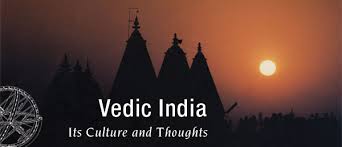The Vedic Period or the Vedic Age refers to that time period when the Vedic Sanskrit texts were composed in India. The society that emerged during that time is known as the Vedic Period, or the Vedic Age, Civilization. The Vedic Civilization flourished between the 1500 BC and 500 BC on the Indo-Gangetic Plains of the Indian subcontinent. This civilization laid down the foundation of Hinduism as well as the associated Indian culture. The Vedic Age was followed by the golden age of Hinduism and classical Sanskrit literature, the Maurya Empire and the Middle Kingdoms of India.
During the early part of the Vedic period, the Indo-Aryans settled into northern India, bringing with them their specific religious traditions. The associated culture (sometimes referred to as Vedic civilization) was initially a tribal, pastoral society centred in the northwestern parts of the Indian subcontinent; it spread after 1200 BCE to the Ganges Plain, as it was shaped by increasing settled agriculture, a hierarchy of four social classes, and the emergence of monarchical, state-level polities.
Read Also: The Sangam Age : Early History of South India
The end of the Vedic period witnessed the rise of large, urbanized states as well as of shramana movements (including Jainism and Buddhism) which challenged the Vedic orthodoxy. Around the beginning of the Common Era, the Vedic tradition formed one of the main constituents of the so-called “Hindu-synthesis”
The reconstruction of the history of Vedic India is based on text-internal details, but can be correlated to relevant archaeological details. The Hindu Vedic Civilisation can be classified into the following five chronological branches:
- Rigvedic text: TheRigveda is by far the most archaic of the Vedic texts preserved, and it retains many common Indo-Iranian elements, both in language and in content, that are not present in any other Vedic texts. It’s time span likely corresponds to the Late Harappan culture,Gandhara Grave culture and Ochre Coloured Pottery culture.
- Mantra language texts: The period of the Mantra Language includes the time of the compilation of the mantra and prose language of the Atharvaveda (Paippalada and Shaunakiya), the Rigveda Khilani, the Samaveda Samhita and the mantras of the Yajurveda. Though derived from the Rig Veda, all these texts experienced wide-scale changes, in terms of language as well as at the time of reinterpretation. This time, period coincided with the early Iron Age in northwestern India and the Black and Red Ware culture.
- Samhita prose texts: The period of Samhita Prose represents the compilation and codification of a Vedic canon. The linguistic changes of this time include the complete loss of the injunctive, the subjunctive, and the aorist. The commentary part of the Yajurveda belongs to the Samhita Prose period. During this time, the Painted Grey Ware culture was evident.
- Brahmana prose texts: TheBrahmanas proper of the four Vedas belong to this period, as well as the Aranyakas, the oldest of the Upanishads. In the east, Videha (N. Bihar and Nepal) is established as the third main political centre of the Vedic period.
- Sutra language texts: The last division of the Vedic Sanskrit can be traced up to 500 BC. During this time, a major portion of the Srauta Sutras, the Grihya Sutras, and some Upanishads were composed.
Must Read: Hindu Literature
Brief Description of Vedic Tradition
- The Vedic Tradition or Hinduism is more than a religion, but a way of life, a complete philosophy.
- It is based on Universal Spiritual Truths which can be applied to anyone at anytime.
- It is called Sanatana-Dharma, the eternal nature of the soul.
- It recognizes that there is one Supreme Being with no beginning or end, the all in all, the unlimited Absolute Truth, which can expand into many forms.
- That Supreme Being is found in the spiritual realm but also lives in the heart of all living beings.
- The Vedic tradition recognizes that the individual soul is eternal, beyond the limitations of the body, and that one soul is no different than another.
- The soul undergoes it’s own karma, the law of cause and effect, by which each person creates his own destiny based on his thought, words, and deeds. The soul undergoes this karma in the rounds of reincarnation.
- The soul incarnates through different forms (called samsara or reincarnation) until it reaches liberation (moksha) from the repetition of birth and death, and attains its natural position in the spiritual domain.
- The Vedic path is based on regaining our natural spiritual identity.
- It has a complete library of ancient texts, known as the Vedic literature, that explain these truths and the reasons for the tradition.
- This Vedic literature is considered to be non-ordinary books that are the basis of the Vedic system. Some of these have been given or spoken by God, and others were composed by sages in their deepest super conscious state in which they were able to give revelations of Universal Truths while in meditation on the Supreme.
- The Vedic path offers personal freedom for one to make his own choice of how he or she wants to pursue their spiritual approach, and what level of the Absolute Truth he or she wishes to understand. This is spiritual democracy and freedom from tyranny.
- The Vedic path consists of ten general rules of moral conduct. There are five for inner purity, called the Yamas—truthfulness, ahimsa or non-injury to others and treating all beings with respect, no cheating or stealing, celibacy, and no selfish accumulation of resources for one’s own purpose. The five rules of conduct for external purification are the niyamas–cleanliness, austerity, perseverance, study of the Vedas, and acceptance of the Supreme Being.
- There are also ten qualities that are the basis of dharmic (righteous) life. These are firmness or fortitude,forgiveness, self-control, refraining from stealing or dishonesty, purity, control over the senses, intellect, knowledge, truth and absence of anger.
Don’t Miss:
Saivism: Origin, Principles, and Kinds








